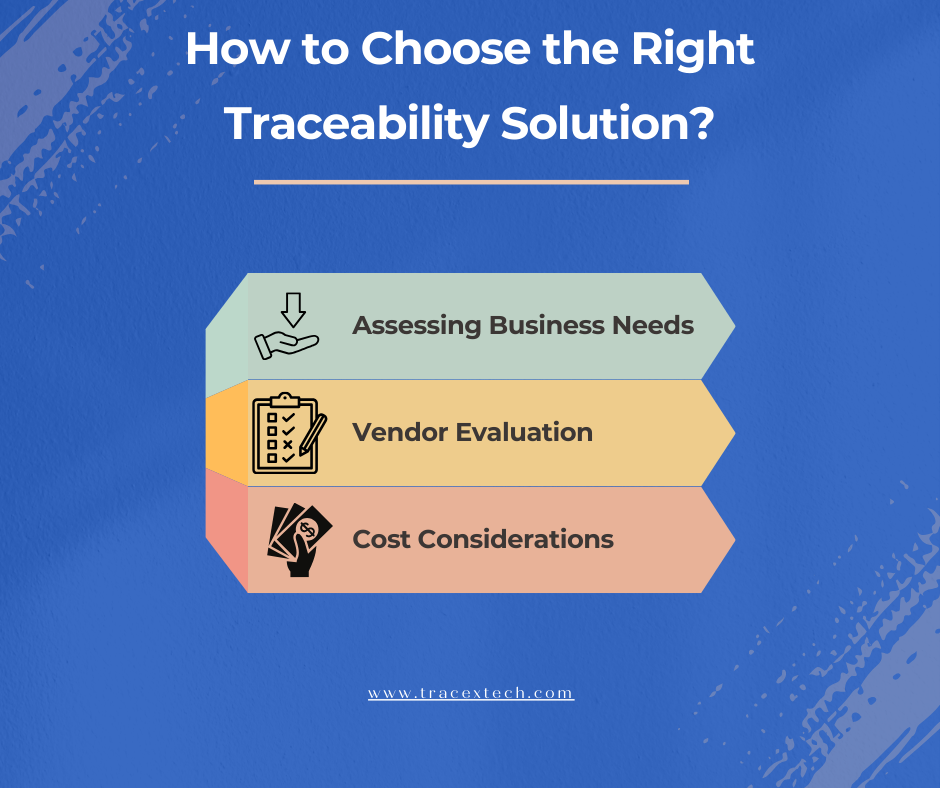Contact: +91 99725 24322 |
Menu
Menu
Quick summary: Unlock the secrets to effective supply chain management with our latest blog on the '6 Things to Look for in a Traceability Solution.' Explore key criteria, from integration features to scalability and user-friendly interfaces. Elevate your traceability game and streamline your operations for a more transparent and efficient supply chain. Read more now!

In the ever-evolving landscape of modern supply chains, traceability has become a cornerstone for ensuring transparency, accountability, and efficiency. As businesses strive to meet the demands of an increasingly conscious consumer base, implementing a robust traceability solution is paramount.
In this blog, we’ll unravel the key elements that define a superior traceability solution. Join us on a journey to discover the six essential factors that can elevate your traceability game, safeguard your brand, and foster a supply chain that not only meets but exceeds expectations. Let’s delve into the intricacies of what makes a traceability solution truly exceptional.
Traceability is the capacity to track and trace the movement of products and their components throughout the supply chain. It is not a one-size-fits-all concept; instead, it takes various forms, each tailored to specific needs within the agriculture sector.
Across diverse industries, traceability is not just a buzzword; it is a linchpin for efficiency, accountability, and consumer trust. In agriculture, the importance of traceability is paramount. It ensures the origin, quality, and safety of produce, addressing critical concerns like contamination or disease outbreaks promptly. Beyond regulatory compliance, traceability has become a hallmark of responsible and sustainable farming practices.
Real-time monitoring involves the continuous tracking of products, processes, or shipments to provide instant updates and insights.
One of the cornerstones of an effective traceability solution is the ability to monitor operations in real-time. This capability allows farmers and producers to track the movement of products, monitor environmental conditions, and respond promptly to changes. Real-time data becomes a powerful tool in identifying inefficiencies, preventing losses, and ensuring optimal conditions for crops.
Real-time monitoring allows for quick decision-making, proactive issue resolution, and improved responsiveness to changing conditions within the supply chain.
Integration features refer to a traceability solution’s ability to seamlessly integrate with existing systems and technologies within a supply chain.
A traceability solution should not exist in isolation. It needs to seamlessly integrate with existing systems, including farm management software, inventory systems, and distribution channels. Integration facilitates a smooth flow of data between various stages of production, distribution, and retail, reducing the chances of errors and delays.
A solution with strong integration capabilities ensures smooth communication between various stages of the supply chain, reducing manual data entry, minimizing errors, and optimizing overall efficiency.
Scalability refers to a traceability solution’s ability to adapt and expand alongside the growth and changes in the supply chain.
Agricultural operations vary significantly in scale, from small family-owned farms to large commercial enterprises. An effective traceability solution must be scalable to accommodate the size and complexity of different farms. Whether it’s a local farmer’s market or a global supply chain, the traceability system should adapt to the specific needs of the business.
As businesses evolve, the traceability system must accommodate increased data volume, additional stakeholders, and new processes without compromising performance.
User-friendly interfaces denote an intuitive and easy-to-use design of the traceability solution, ensuring accessibility for all stakeholders.
The success of any technological solution hinges on user adoption, and traceability is no exception. An intuitive and user-friendly interface is paramount for successful implementation. Farmers and workers need to easily navigate and input data. A well-designed interface not only enhances user experience but also reduces the learning curve, making it accessible to individuals with varying levels of technological proficiency.
An effective traceability solution should simplify data collection and entry for users. Given the diverse range of stakeholders situated in various countries with different language preferences, it is crucial to adopt a solution that is both intuitive and effortless for all participants.
A user-friendly interface enhances adoption rates, reduces training time, and encourages collaboration among different teams and individuals involved in the supply chain.
A networked approach implies the ability of the traceability solution to connect and share information seamlessly across all stakeholders in the supply chain.This collaborative approach enhances transparency, reduces information silos, and fosters better communication among suppliers, manufacturers, distributors, and retailers.
Effectively tracing a supply chain requires a collaborative approach, as no single organization can achieve it alone. A networked strategy is vital for success in tracing. Your traceability solution must have the capability to establish connections among brands, retailers, suppliers, and all pertinent facilities and organizations within the supply chain. This connectivity enables seamless collaboration in the tracing process, providing a more comprehensive view of the supply chain and enhancing the ability to promptly track any changes.
Data security involves measures and protocols in place to protect sensitive information from unauthorized access, breaches, or tampering. In a world of increasing cyber threats, a robust traceability solution must prioritize data security to safeguard the integrity and confidentiality of the supply chain information.
When managing sensitive data like product traceability information, prioritizing security is imperative. It is crucial to ensure that your data, documents, and information are safeguarded consistently. Verify that your traceability solution provides encryption, secure data transmission protocols, and access control mechanisms to guarantee that only authorized personnel can access the data. Moreover, it should align with the most rigorous global data security standards, including GDPR and others, to guarantee the safe collection and storage of your supply chain traceability information and documents.
Adhering to industry standards and regulations is non-negotiable in agriculture. Traceability solutions play a pivotal role in ensuring compliance. From adherence to food safety standards to meeting labeling requirements, a robust traceability system reduces the risk of fines and legal complications.
Traceability provides a transparent view of the entire supply chain. This visibility is invaluable for farmers and producers in identifying inefficiencies, reducing waste, and optimizing processes for better resource management. With a clear understanding of the flow of products from farm to market, stakeholders can make informed decisions that positively impact the entire supply chain.
Traceability contributes to the overall improvement of product quality. By tracing the journey of each product, farmers can identify and rectify issues that may affect quality. This, in turn, leads to consistently higher-quality products that meet and exceed consumer expectations. The assurance of quality enhances brand reputation and consumer trust, fostering long-term relationships.
Agriculture is fraught with various risks, from disease outbreaks to contamination. Traceability solutions act as a risk mitigation tool, enabling swift identification and isolation of affected products. In the event of a food recall, traceability allows for targeted removal of specific batches, minimizing the impact on the entire supply chain. This not only protects consumers but also safeguards the reputation of the farm or company.

Resistance to change is a common hurdle in any industry, and agriculture is no exception. Farmers may be accustomed to traditional methods and could resist the adoption of new technologies. Overcoming this resistance requires a concerted effort in education and awareness. Clearly communicating the benefits of traceability, both in terms of operational efficiency and compliance, is essential. Demonstrating tangible improvements through pilot programs can also alleviate concerns and build confidence among stakeholders.
The successful implementation of traceability solutions necessitates comprehensive training for farm workers and relevant personnel. Clear and concise training programs are vital to ensuring effective utilization of the system. Training should cover not only the technical aspects of using the traceability solution but also the broader understanding of why traceability is essential for the success and sustainability of the farm.
TraceX, powered by blockchain technology, seamlessly integrates with diverse systems and technologies across the supply chain. Its interoperability ensures smooth communication, minimizing manual input errors and optimizing overall operational efficiency. It offers a scalable solution that adapts to the evolving needs of businesses. It efficiently accommodates increased data volume, additional stakeholders, and new processes without compromising performance, providing a future-proof traceability system.
With robust blockchain encryption, TraceX prioritizes data security. It employs advanced measures and protocols to protect sensitive information, ensuring unauthorized access, breaches, or tampering are mitigated, thus upholding the integrity and confidentiality of supply chain data. TraceX solutions adhere to GDPR and SOC2 compliance standards. This commitment to data protection and privacy further reinforces the comprehensive and effective approach TraceX brings to managing and optimizing supply chain processes.
TraceX adopts a networked approach, connecting brands, retailers, suppliers, and all relevant stakeholders seamlessly. This collaborative environment enhances transparency, reduces information silos, and fosters improved communication throughout the supply chain. Powered by blockchain’s real-time capabilities, TraceX ensures continuous monitoring of products, processes, and shipments. This enables instant updates and insights, facilitating quick decision-making, proactive issue resolution, and heightened responsiveness to changing supply chain conditions. TraceX boasts user-friendly interfaces designed for intuitive use. Its accessible design enhances adoption rates, reduces training time, and promotes collaboration among diverse teams and individuals engaged in various supply chain processes.
The future of traceability solutions in agriculture is intrinsically linked to technological advancements. The integration of Internet of Things (IoT), blockchain, and Artificial Intelligence (AI) is expected to revolutionize traceability. These technologies offer unprecedented levels of accuracy, transparency, and efficiency in tracking and tracing products throughout the supply chain.
Internet of Things (IoT): IoT devices, such as sensors and RFID tags, can be deployed at various points in the supply chain. These devices provide real-time data on environmental conditions, product location, and other crucial parameters. The data generated by IoT devices enhances the precision and granularity of traceability information.
Blockchain: Blockchain technology ensures an immutable and transparent ledger of transactions. In the context of traceability, blockchain can be employed to create an unalterable record of each product’s journey. This not only enhances trust but also facilitates instant verification of product authenticity.
Artificial Intelligence (AI): AI applications, including machine learning algorithms, can analyze vast datasets generated by traceability solutions. This analysis can uncover patterns, optimize supply chain processes, and predict potential issues before they escalate. AI-driven insights contribute to more informed decision-making and proactive risk management.
In conclusion, the implementation of an effective traceability solution transcends being a technological upgrade; it is a strategic move towards a sustainable and efficient agricultural future. The considerations outlined in this exploration provide a comprehensive roadmap for farmers and producers to navigate the complexities of traceability. By doing so, they ensure they reap the maximum benefits for their operations, from regulatory compliance to enhanced efficiency and consumer trust.
